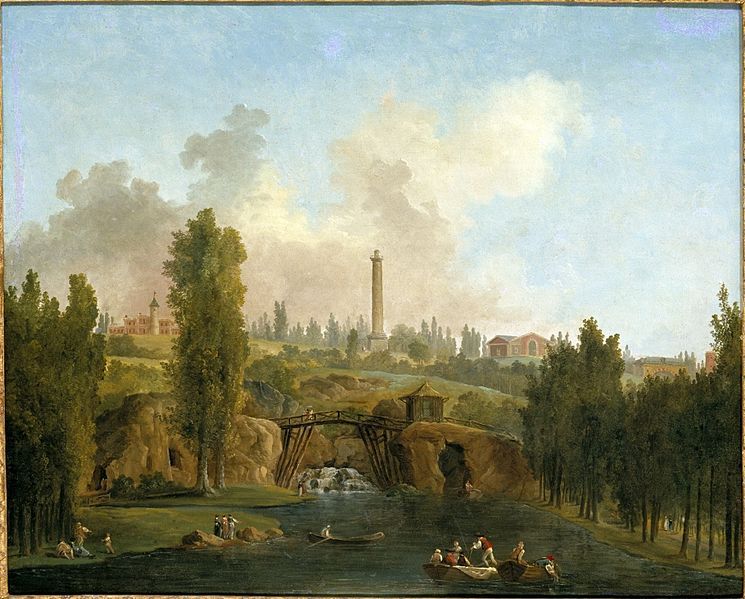The Role of the Painter-Gardener
Beyond his ruin paintings, Robert was well known as a garden designer for many members of the French nobility. Robert’s role as the “painter-gardener”, a hybrid role, enabled the artist to dabble between the “worlds of two- and three-dimensional illusionism.”1 Most notably, Robert served as the chief garden designer and painter for the Château de Méréville, owned by the Marquis de Laborde dates, a banker and tax collector for the French court, who acquired the estate in 1784.
Hubert Robert and the Marquis de Laborde maintained a consistent correspondence between 1786-17932. It was from this communication that Robert was commissioned to oversee the development of the picturesque landscape, modeled after the British landscape tradition, at the Château. Robert was instructed to capture Laborde’s deep interest in classical antiquity, up to and including copies of famous classical sculptures and architectural elements in the park. Robert, along with six sculptors3, designed a garden that incorporated the pre-existing natural forms along with man-made structures such as temples, obelisks, and other buildings reminiscent of Ancient Rome. The inclusion of ruins in the park was heavily in vogue in the late 18th century, as it pointed to the wealth and refined taste of the landowner. Robert, borrowing from his own understanding of landscape aesthetics, made an effort to construct interesting and dynamic views from all perspectives of the garden. Robert challenged visitors to witness new and spectacular views while walking through the garden, and simultaneously offered surprising views to be discovered4.
Robert’s mastery as the “painter-gardener” is evident in his painting, View of the Park at Méréville, painted in 1786 and is a depiction of the grounds at Méréville. The painting shows Robert’s hand in selecting an obelisk overlooking basins of water. Meant to serve as a “land of illusions”5, the park utilizes the dynamism and irregularity of natural cliffs and streams. Classical structures situate the viewers in an artificially constructed location while simultaneously offering a bucolic return to nature.
Soon after the completion of the garden, Robert also painted six paintings for the Château. Two paintings were hung in the billiard room and four were to be in the Marquis’ petit salon6. Though Robert is best known as a ruins painter, his endeavors and role as a “painter-gardener” enabled him to influence the emotive qualities of both a physical garden landscape and the imagery associated with nature in his garden commissions. The role of the painter-gardener, like that of the role of a ruins painter, legitimized the status and education of a painter like Robert. The artist was a jack of all trades and could easily cater to the tastes of the upper classes. Robert incorporated his creativity in architectural planning and knowledge of Roman antiquity in a garden landscape, thus demonstrating his resourcefulness and creativity as an artist.
KC
______________________________________________________________________________
1Bandiera, John D. “Form and Meaning in Hubert Robert’s Ruin Caprices: Four Paintings of Fictive Ruins for the Chateau de Mereville.” Art Institute of Chicago Museum Studies 15, no.1 (1989), 22
2Grasselli, Margaret Morgan, and Yuriko Jackall. “Robert and the Art of Decoration” Hubert Robert. Washington: National Gallery of Art, 2016, 36
3 Ibid., 36
4 Ibid., 39
5 Bandiera, John D. “Form and Meaning in Hubert Robert’s Ruin Caprices: Four Paintings of Fictive Ruins for the Chateau de Mereville.” Art Institute of Chicago Museum Studies 15, no.1 (1989), 26
6 Bandiera, John D. “Form and Meaning in Hubert Robert’s Ruin Caprices: Four Paintings of Fictive Ruins for the Chateau de Mereville.” Art Institute of Chicago Museum Studies 15, no.1 (1989), 22
